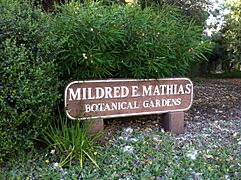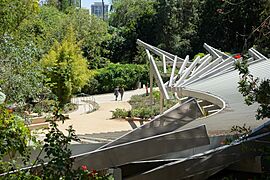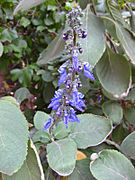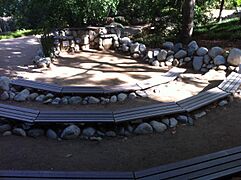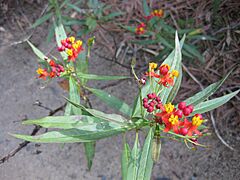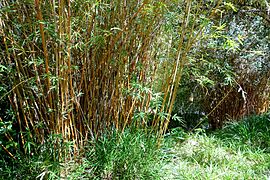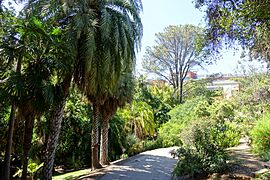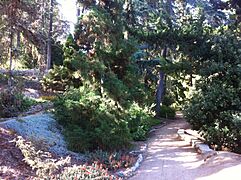Mildred E. Mathias Botanical Garden facts for kids
Quick facts for kids Mathias Botanical Garden |
|
|---|---|
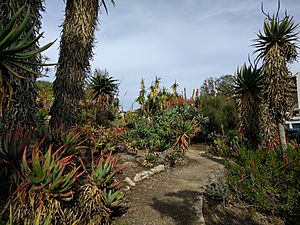
Aloes at the garden
|
|
| Lua error in Module:Location_map at line 420: attempt to index field 'wikibase' (a nil value). | |
| Type | Public |
| Location | Los Angeles, California, United States |
| Nearest city | Los Angeles |
| Area | 7 acres (2.8 ha) |
| Created | 1906 by Mildred Esther Mathias Hassler |
| Status | Open year round |
The Mathias Botanical Garden is a super cool outdoor space at the UCLA campus. It's like a living museum with over 3,000 different kinds of plants! This amazing 7-acre garden is named after Mildred Esther Mathias Hassler, a famous plant scientist. Guess what? It's the only free public botanical garden in the whole Greater Los Angeles area, so everyone can visit and explore. The garden's director is Victoria Sork.
Contents
A Look Back: How the Garden Grew
The UCLA botanical garden began way back in 1929, not long after the Westwood, Los Angeles campus opened. It was first used as a special outdoor classroom for students to study plants. The garden got some help from the California State Relief Administration, which provided jobs during tough times.
George C. Groenewegen was the garden's first manager. He started collecting plants from places like the United States Department of Agriculture and the Huntington Botanical Gardens. By 1947, the garden had about 1,500 different types of plants!
Mildred Mathias's Impact
In the 1960s, a wonderful scientist named Mildred E. Mathias took charge. She helped turn it into a "university garden" and opened it up for everyone to enjoy. The garden grew to include special areas for palms, succulents, and aquatic plants.
A special building for teaching and research was finished in 1952. Later, a recycling stream and ponds were added, making the garden even more beautiful. Since the early 1960s, the garden has focused on growing amazing tropical and subtropical plants, especially those with big, colorful flowers.
Honoring a Legacy
In 1979, the garden was officially named the Mildred E. Mathias Botanical Garden. This honored Dr. Mathias for all her hard work and contributions. By then, the garden had grown so much it felt like a forest!
Dr. Arthur C. Gibson became the director in 1980. He worked to let in more sunlight, which helped many sun-loving plants thrive. Over time, new special collections were added. These included Malesian rhododendrons, bromeliads, cycads, ferns, and plants from Hawaii.
Modern Additions and Accessibility
In 1996, an outdoor classroom called The Nest was built. It has cool semicircular benches for students and visitors. Later that year, new paths were added on the western side of the garden. These gently sloped paths make it easy for everyone, including those with disabilities, to explore The Nest and the special plant collections.
Today, a dedicated team and about 30 student volunteers keep the garden looking amazing.
Amazing Plant Collections
The Mathias Botanical Garden is home to many incredible plants. Here are some of the highlights you can discover:
- Over 3,000 different kinds of living plants, including a unique collection of tropical and subtropical trees.
- A rich collection of plants from East Asia and Australia.
- More than 60 different types of palms.
- One of the largest Torrey pines in the world.
- One of the tallest dawn redwoods in North America. This rare "living fossil" was planted in 1948, shortly after the species was rediscovered in China.
- A diverse collection of succulents that show how plants from different deserts can look similar.
- A lush and green fern garden.
Because the garden rarely freezes, it's perfect for tropical and subtropical plants. You'll find special collections of ferns, palms, eucalyptus, and figs. The eucalyptus and figs were brought to the garden many years ago, before they were common in Los Angeles. Plants are arranged in ways that help students and visitors understand how different species are related.
Themed Garden Sections
As you walk through the garden, you'll find various themed sections. These include the California Native Garden, the Mediterranean Garden, the Hawaiian Garden, and the Ancient Forest Section. These areas let you explore plants from all over the world!
The garden also has a special "herbarium." This is like a library for dried and pressed plant specimens. It holds 150,000 specimens, mostly from California and the Western United States. It also has a library full of books and journals about plants.
Notable Specimens to See
The garden has some truly special trees and plants that are worth finding:
- A huge dawn redwood from China. This species was once thought to be extinct, making it a very rare and important tree.
- A large Torrey pine, which is a rare tree mostly found near San Diego, California. It even has its own nature reserve there!
- In the Hawaiian Section, you'll see many colorful Hawaiian hibiscus plants. This beautiful flower is the state flower of Hawaii.
- The palm section features palms from around the world. Look for the Chilean wine palm (Jubaea chilensis), the Spiny fiber palm (Trithrinax acanthocoma), Pygmy Date Palm (Phoenix roebelenii), and Texas Palmetto (Sabal mexicana).
Gallery
See also
 In Spanish: Jardín Botánico Mildred E. Mathias para niños
In Spanish: Jardín Botánico Mildred E. Mathias para niños
- Mildred Esther Mathias
- List of botanical gardens in the United States
- California native plants
- South Coast Botanic Garden
- Santa Barbara Botanic Garden
- California Botanic Garden
- Manhattan Beach Botanic Garden


